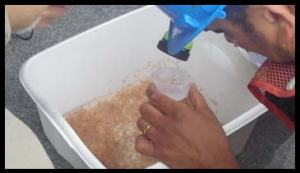NOAA Teacher at Sea
Michael Wing
Aboard R/V Fulmar
July 17 – 25, 2015
Mission: 2015 July ACCESS Cruise
Geographical Area of Cruise: Pacific Ocean west of the Golden Gate Bridge
Date: Saturday, July 18, 2015
Weather Data from the Bridge: Wind Southeast, ten knots. Wind waves less than two feet. Swell 4-6 feet ten seconds. Patchy morning fog.

Science and Technology Log
We loaded the boat yesterday at 3:00 PM and I met a lot of people including the three co-principal investigators Jan Roletto of the Greater Farallones National Marine Sanctuary, Danielle Lipski of the Cordell Bank National Marine Sanctuary, and Jaime Jahncke of Point Blue Conservation Science. There are others, including volunteers and visitors, and I will try to introduce some of them in future posts.
Today we didn’t collect water or plankton samples. We’ll do that tomorrow. We sailed west from the Golden Gate Bridge on a track called “Line 5” at ten knots until we passed the edge of the continental shelf and then dropped south and cruised back to our dock in Sausalito on another line called “Line 7.” Plankton and water samples are for the even-numbered lines. Our purpose today was to count seabirds, whales and seals and sea lions. It’s not simple. By 7:30 AM we are assembled on the “flying bridge” (the highest part of the boat) with Jaime and the Greater Farallones Association’s Kirsten Lindquist on the starboard side and volunteers Jason Thompson and Rudy Wallen on the port. Kirsten notes birds, focusing just on the area from dead ahead to the starboard beam and calls out things like “Common murre, zone two, thirteen, flying, bearing 330 degrees.” This means she saw thirteen common murres flying northwest together not too far from the boat. This time is called being “on effort” and she is really focused on it. I don’t talk to her unless spoken to. Jamie enters all this into a database on his laptop.

The guys on the port side are doing the same thing for marine mammals and saying “Animal, by eye, bearing 320, reticle seven, traveling, immature California sea lion, one-one-one.” These last numbers are estimates of the most probable number of animals in the group, and maximum and minimum estimates. Obviously, in this example just one animal was seen.
I am in awe of their ability to identify species, maturity and other things from just a glimpse. Kirsten can tell the difference between a Western gull and a California gull from hundreds of feet away, even if the gull is flying away from her. They also record floating trash, dead animals, and boats and ships.
So what are we seeing? Common murres, western gulls, California gulls, Sabine’s gulls, sooty shearwaters, pink footed shearwaters, storm petrels, black footed albatrosses, red necked phalaropes, tufted puffins, Pacific white sided dolphins, northern fur seals, a bottlenose dolphin, humpback whales, a dead seal, Mola molas (ocean sunfish), one flying fish, mylar balloons (4), a paper cup, a piece of Styrofoam. The flying fish was totally unexpected because they are mostly tropical and everyone talked about it all afternoon.

Some of these birds have come here from Chile, New Zealand, or Hawaii in their “off” (non-breeding) season because there is a world-class food supply here for them. The sooty shearwaters start in New Zealand and fly to Japan, to Alaskan waters, and then down the west coast of North America before returning to New Zealand across the Pacific! However, a lot of these were far away. Visually, the ocean looks pretty empty from the flying bridge.

Personal Log
The specter of seasickness haunts us on the first day of a cruise. Most of us are snacking on starchy treats like pretzels and Cheez-Its and drinking carbonated drinks. Paradoxically, these foods help prevent nausea. I have not taken any seasickness medicine and I am feeling a little queasy during the morning, but by noon I feel great. Nobody throws up. The Fulmar doesn’t roll from side to side very much but she does lurch when smacked head-on by a wave. It helps that the waves weren’t very big today. Soon we’ll all get our “sea legs.”
Also, you might appreciate these photos of me getting into a “Gumby suit” in under a minute, as part of my safety training. This is a survival suit meant to keep you from freezing to death if the boat sinks. You have to be able to get into it in less than a minute.


Did You Know? Here’s what you need to untangle fishing nets from a frustrated humpback whale: Boathooks, sharp knives, and a GoPro digital camera on the end of a pole. The GoPro helps you study the tangles so you can decide where to make that one cut that causes the whole mess to fall apart and off the whale.


















 On my voyage I will be joining the crew and scientists aboard the Research Vessel
On my voyage I will be joining the crew and scientists aboard the Research Vessel 










